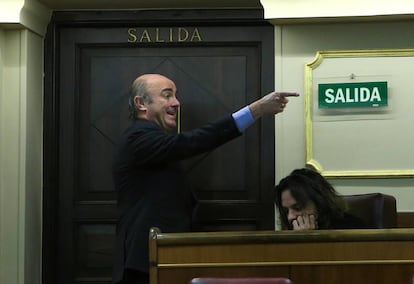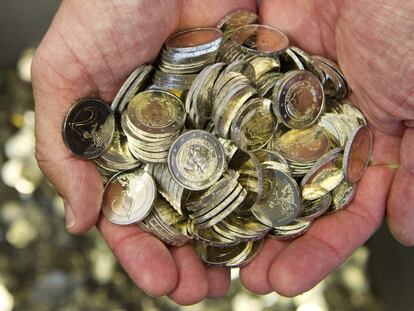Brussels raises Spain’s GDP growth forecast for 2018
As the threat from the Catalan crisis subsides, EU Commission sets new figure at 2.6%, up from 2.5%

Spain has got a good grade from European Union economic authorities on the same day that it is nominating a candidate to the European Central Bank (see sidebar).
In November, the European Economic Forecast had reported that it was too soon to gauge the effects of the Catalan crisis on the Spanish economy, even though Madrid was already putting the cost at €5 billion.
Public debt is still close to 100% of GDP, making Spain vulnerable if lean times return
But the new EU winter forecast, due out later on Wednesday, sees little to no impact from that crisis, and raises its 2018 GDP growth forecast for Spain from 2.5% to 2.6%.
According to the European Commission, the Spanish economy will subsequently slow down its pace, falling to 2.1% in 2019.
Other economic indicators show a trade surplus but very high levels of debt and unemployment, which stands at 17.4% of the labor force. Brussels thinks that this figure will continue to shrink over the next two years, to reach around 14% in 2019.
Inflation was 2% in 2017 and is expected to drop to 1.6% in 2018 and 1.5% in 2019.
Return to growth
Spain’s output returned to pre-crisis levels in mid-2017, and is now growing at a much faster pace than the EU average.
A nominee for the ECB
Wednesday is the deadline for sending in applications to the board of the European Central Bank (ECB). PM Mariano Rajoy has named Economy Minister Luis de Guindos as the Spanish nominee to replace outgoing ECB vice-president Vítor Constâncio. Two years ago, De Guindos lost out to Jeroen Dijsselbloem in the race for the ECB presidency.
With the recession finally overcome, what worried Brussels about Spain was the potential effects of the secessionist challenge in Catalonia, and the political weakness of a minority government unable to get the 2018 budget passed.
The budget is yet to get green-lighted, but experts estimate that Spain will reduce its deficit to well under 3% of GDP this year.
Public debt, on the other hand, is close to 100% of GDP (it stood at €1.14 trillion in November 2017), which puts Spain in a vulnerable position should lean times return.
Other forecasts
Meanwhile, the Spanish government’s own 2018 growth forecast is set at 2.3%, a figure that was arrived at in October of last year, around the time of the illegal independence referendum in Catalonia. Last week, Prime Minister Mariano Rajoy announced that the forecast will be raised to “at least 2.5%.”
The International Monetary Fund (IMF), for its part, has reviewed its October forecast for Spain down from 2.5% to 2.4%, as a reflection of “political uncertainty.”
The Bank of Spain’s most recent 2018 forecast came out in December, and likewise set GDP growth at 2.4%.
English version by Susana Urra.
Tu suscripción se está usando en otro dispositivo
¿Quieres añadir otro usuario a tu suscripción?
Si continúas leyendo en este dispositivo, no se podrá leer en el otro.
FlechaTu suscripción se está usando en otro dispositivo y solo puedes acceder a EL PAÍS desde un dispositivo a la vez.
Si quieres compartir tu cuenta, cambia tu suscripción a la modalidad Premium, así podrás añadir otro usuario. Cada uno accederá con su propia cuenta de email, lo que os permitirá personalizar vuestra experiencia en EL PAÍS.
¿Tienes una suscripción de empresa? Accede aquí para contratar más cuentas.
En el caso de no saber quién está usando tu cuenta, te recomendamos cambiar tu contraseña aquí.
Si decides continuar compartiendo tu cuenta, este mensaje se mostrará en tu dispositivo y en el de la otra persona que está usando tu cuenta de forma indefinida, afectando a tu experiencia de lectura. Puedes consultar aquí los términos y condiciones de la suscripción digital.
More information
Archived In
Últimas noticias
The complicated life of Francesca Albanese: A rising figure in Italy but barred from every bank by Trump’s sanctions
How Japan is trying to avert ‘digital defeat’
Half of Scotland is in the hands of 420 property owners
Reinhard Genzel, Nobel laureate in physics: ‘One-minute videos will never give you the truth’
Most viewed
- Pablo Escobar’s hippos: A serious environmental problem, 40 years on
- Why we lost the habit of sleeping in two segments and how that changed our sense of time
- Charles Dubouloz, mountaineering star, retires at 36 with a farewell tour inspired by Walter Bonatti
- Reinhard Genzel, Nobel laureate in physics: ‘One-minute videos will never give you the truth’
- The Florida Keys tourist paradise is besieged by immigration agents: ‘We’ve never seen anything like this’











































